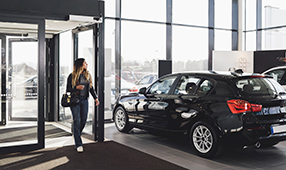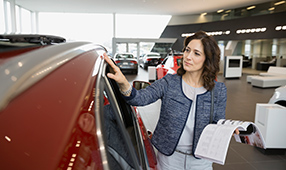When you buy or lease a new car, you’re likely evaluating the sticker price to figure out what you can afford. But that new car will actually cost you more than that over the long run once you factor in taxes, fees, finance charges, maintenance, insurance and fuel.
You’ll also need to consider an intangible “cost” you’ll incur: As your car ages, it depreciates, which means its value dramatically reduces. This is important if you’re planning to trade it in eventually for a newer car.
Here’s what you need to know about the total cost of ownership if you’re thinking about buying a new or used vehicle. The percentages in this chart indicate the amount that each factor can add to the cost of a new car during the first five years you own it, according to TrueCar data:

Fees and taxes: 5%
Depending on where you live, you may have to pay local city and state taxes in addition to your new car’s purchase price. According to TrueCar data, items such sales taxes, license and registration can add up to 5% to the purchase price.
Financing costs: 5%
These may vary significantly depending on your credit rating, as well as with any special deals and incentives the manufacturer is offering. According to TrueCar data, the average cost of financing a new car is 5% or more, although that does include all active vehicle loans during the research period, as well as sub-prime rates being paid by buyers with poor credit and great annual percentage rates (APRs) being paid by buyers with excellent credit.
Before you shop, be sure to know your credit score so you’ll know what to expect to pay when you finance your new vehicle. Otherwise, you risk finding out too late that you don't qualify for a loan on the car you’ve got your heart set on.
Maintenance costs: 9%
Keeping your vehicle in good working order can add up, especially if you’re buying a car with cutting-edge technology or a luxury or high-performance vehicle that may cost more to maintain.
So what does it cost to keep your new car running? Oil changes and filters, new brakes and tires, brake and transmission fluids and even special urea additives for some high-tech diesel engines could end up on your mechanic’s to-do list.
The good news is that many new cars have reduced maintenance needs (always refer to your owner’s manual for recommendations about service intervals), and many manufacturers such as BMW, Cadillac, Lincoln, Mini, Toyota and Volkswagen include maintenance programs for new car buyers. TrueCar data shows maintenance can add 9% to the cost of a new car over its first five years.
Insurance: 17%
TrueCar data shows that automotive insurance can add as much as 17% to the cost of a new car. It might seem backward to check with your insurance agent before you buy a car, but if you know that the premiums are going to be sky-high for a certain vehicle, then you’d be more likely to select a different model or cut back on some of the extras.
Fuel: 28%
Depending on how much you drive, the current gasoline prices and your new car’s fuel economy, fuel costs can add an average of 28% to the cost of ownership. As you’re browsing, check the window stick to find out the estimated fuel costs for the car you’re considering. Fuel economy ranges are listed for city and highway miles, and they include a “combined” rating that will help you compare that vehicle to others in its class.
The annual estimated fuel cost quoted here is based on what it would cost to drive your new vehicle 15,000 miles a year, based on 45% city and 55% highway driving at current fuel prices.
Depreciation: 36%
The biggest variable on any new car purchase is depreciation. However, it shouldn’t be a deterrent to buying a new car, especially if you plan to keep the vehicle for a long time or if you’re planning to lease. Once you drive a vehicle off the dealership lot, it depreciates in value.
“It's important to understand the resale value of the vehicle you’re considering purchasing, because depreciation varies per vehicle,” says Jesse Toprak, TrueCar senior analyst. “In general, a vehicle loses 15-20% of its value per year, with the first year being the steepest.”
That’s due to the change in value between the retail price you pay at the dealership and the wholesale value it’s worth once it has left the lot, Toprak says.
According to TrueCar data, the average depreciation of new cars is about 36% over five years. It’s such an important aspect of vehicle leases that companies such as ALG rank all new vehicles on their future residual value and honor the vehicles in each segment that are forecast to retain the highest percentage of MSRP after a three-year period.
“Residual value is a complete indicator of vehicle value, taking into account quality, durability and brand desirability,” said Larry Dominique, president of ALG.
One way to reduce the total price you pay
Keep your overall costs low by starting with the best purchase price possible. Whether you plan to purchase or lease your next new car, consider shopping through The NEA Auto Buying Program to see upfront guaranteed savings off MSRP from a TrueCar Certified Dealer. You also can track additional savings, new incentives, price drops and special offers.
*NOTE: Percentages in the accompanying chart are estimated 5-year cost of ownership and based on a $30,000 car.












